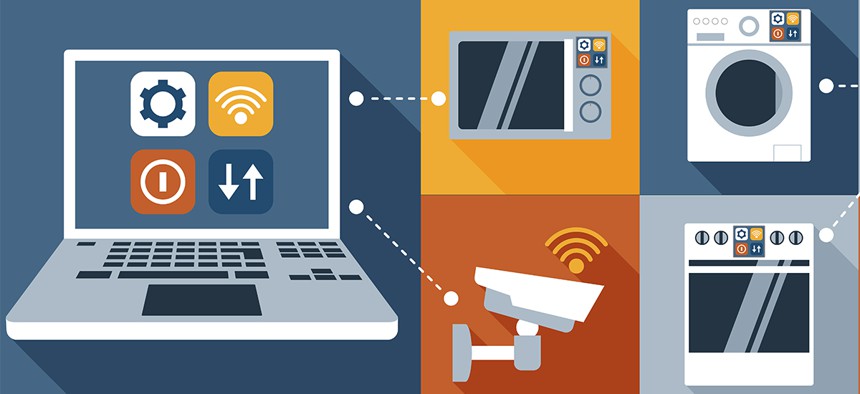How the Federal Government Is Attempting to Protect the Internet of Things

Macrovector/Shutterstock.com
Federal attempts to protect the network of devices and sensors -- for consumers and agencies -- are gradually building.
As the "Internet of Things” enters common parlance, the federal government’s attempts to protect the network of devices and sensors -- both for consumers and government agencies -- are gradually building.
For consumers, an unprotected network could grant criminals access to their financial data, or even allow hackers to kill the transmission of their cars, as demonstrated in Wired this summer. For federal agencies beginning to use sensor networks -- perhaps to monitor the location of truck fleets or rail lines, among other applications -- the physical risks resulting from cyber intrusions multiply, according to Deloitte researcher Joe Mariani.
“The threats are different,” as Mariani put it. As consumers plug into the Internet of Things, they’re most vulnerable to criminals aiming to exploit their personal data.
“The government data does face another threat from more malicious actors who don’t just want data for their own purposes,” but are interested in perpetrating larger-scale data breaches, falsifying data or controlling the physical assets on the network, he explained.
A new report from tech research firm IDC forecasts that government use of the Internet of Things will grow at a compound annual rate of 17.1 percent until 2018. In March, the Senate passed a National Resolution for the Internet of Things, which proposed that the government "commit itself to using the Internet of Things to improve its efficiency and effectiveness and cut waste, fraud and abuse whenever possible.”
As federal adoption grows (current users span from the U.S. Geological Survey, which uses sensors to monitor river bacteria, to the State Department using iPhones to detect nuclear weapons testing), there are a handful of recent efforts to secure the Internet of Things -- and also to generally warn users about its potential pitfalls.
In September, for instance, the U.S. Computer Emergency Response Team and the FBI issued alerts about security risks associated with the Internet of Things. Among scenarios they outlined were criminals breaking into connected gas pumps and creating gas shortages or overfilling vehicles’ tanks to dangerous levels.
The FBI and CERT security warnings suggested users “isolate IoT devices on their own protected networks” and upgrade device passwords to strong ones, among other tips.
That same month, the Defense Advanced Research Projects Agency announced plans to award $36 million for the first phase of research about systems that can monitor devices in the Internet of Things. That project intends to focus on the involuntary emissions from devices -- electromagnetic, acoustic, thermal, and power fluctuations to gather information about software running on the device. (This could help researchers tell which part of a device’s memory is being accessed, according to the DARPA announcement.)
Another ongoing DARPA program called SHIELD -- Supply Chain Hardware Integrity for Electronics Defense -- aims to detect counterfeited circuits or impostor devices.
The National Security Agency even has a laboratory dedicated to the Internet of Things. Its Laboratory for Telecommunication Sciences studies the security elements in networks of devices from various manufacturers.
The National Institute of Standards in Technology has been drafting standards for privacy and security for technology companies, ultimately aimed at protecting Internet of Things adopters including consumers and government users. Also in September, NIST released a Draft Framework for Cyber-Physical Systems, meant to serve as a how-to guide for device manufacturers attempting to create safer devices.
Traditionally, "IT cybersecurity" focuses on "mitigating the impact of cyberattacks," that framework said. Standards for the Internet of Things, a "cyberphysical system" -- or a virtual network controlling physical entities -- must "consider the coordinated exploitation of both physical and cyber vulnerabilities," according to that framework.
NIST is also developing standards aimed at protecting consumer privacy in the Internet of Things, noted Isaac Potoczny-Jones, research lead for computer science at Galois, a company working with NIST on consumer privacy.
“A lot of the Internet has this financial basis around making the user into the product, not the consumer," he told Nextgov. "The user’s private data is really the product and that product is sold elsewhere -- we see a potential for that happening on the Internet of Things."
Galois is working with NIST on a pilot in which consumers' information, culled from smart-home services, could be integrated into a "privacy preserving data store," Potoczny-Jones said.
These efforts to protect the Internet of Things have arisen out of necessity -- connectivity is simply too ubiquitous to ignore, Deloitte Director of Public Sector Research Bill Eggers, who recently co-authored a report on the Internet of Things in Government, said in an interview.
"It's not whether the government gets to decide whether they're going to go all in on [Internet of Things] or not," he said. "Governments really have no choice."
Correction: An earlier version of this article misstated Joe Mariani's job title.
(Image via Macrovector/Shutterstock.com)
NEXT STORY: GSA Looks for New Chief Customer Officer





